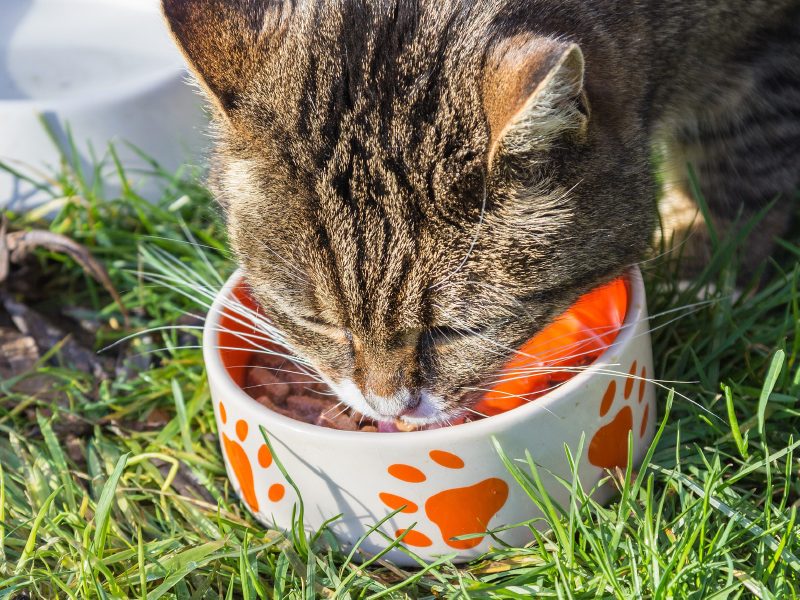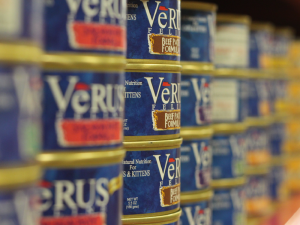What’s In Your Cat’s Food?

 Anyone familiar with the expression, “You are what you eat”, will understand that cats are only as healthy as the food in their bowls.
Anyone familiar with the expression, “You are what you eat”, will understand that cats are only as healthy as the food in their bowls.
An ever-increasing number of nutrition conscious veterinarians now strongly recommend cat owners feed their finicky and not so finicky felines canned food rather than dry food or kibble.
Why? Consider these three major reasons:
One: The water content in dry food is too low.
Cats are “designed” to get most of their water from their diet. Left in their natural habitat, where small animals are their prey, they would derive nearly 70% of their water by ingesting them. Whereas dry foods are cooked harshly (highly processed), leaving only 5 to 10% water behind, canned foods contain nearly 78% water.
Although cats do drink water from their water bowls, it doesn’t make up for the high water loss in their kibble. And according to several recent studies, cats fed canned food consume DOUBLE the amount of water when compared with cats being fed dry food when both sources (food bowl and water bowl) are taken into account.
A diet of canned food can help prevent your cat from developing serious urinary tract problems including infections, inflammation (cystitis), painful, sometimes fatal urethral blockages and chronic kidney disease, which is a leading cause of death in cats.
Two: The carbohydrate level in dry food is too high.
Cats do NOT need carbohydrates such as grains, potatoes and peas in their diet. The average dry food contains 35 to 50% carbohydrate calories, while a high quality canned food contains between 3 and 5%.
Even dry food labeled “low in carbs” is still highly processed, depleting it of water and most of its nutrients. Once again, in their natural habitat, cats would derive less than 2% of their daily caloric intake from carbohydrates. (Please note that some canned cat food labeled “low in carbs” may also contain high levels of grains, peas and potatoes).
A diet low in carbohydrates can help prevent your cat from becoming obese, and from developing diabetes and intestinal disease.
Three: Dry food is too high in plant-based, grain proteins such as corn, wheat, rice and soy. As carnivores, cats are meant to eat meat, high in the complete proteins they need to build and maintain strong bones and healthy bodies. Using “grain free” cat food doesn’t necessarily mean it’s low in carbohydrates because peas and potatoes are simply substituted for the grains.
Other negative issues to consider when feeding your cat dry food are allergic reactions to some of the ingredients; bacterial contamination, which can cause vomiting and diarrhea; fungal mycotoxins which are contained in grains and are extremely toxic; and insects and their feces, which can cause respiratory problems.
 Transitioning cats from dry to wet food, like any other change, requires time and patience. Whether it takes a day, a week or a month, always ensure your cat eats ENOUGH in a single day to prevent the risk of hepatic lipidosis (a life threatening liver condition that can develop when a cat goes without food for over 24 hours).
Transitioning cats from dry to wet food, like any other change, requires time and patience. Whether it takes a day, a week or a month, always ensure your cat eats ENOUGH in a single day to prevent the risk of hepatic lipidosis (a life threatening liver condition that can develop when a cat goes without food for over 24 hours).
Begin by establishing a fixed feeding schedule and do NOT deviate from it. Make the wet food as appealing as possible by warming it slightly to release the aroma before putting it in the bowl. If your cat is resistant at first, sprinkle some dry food on top of the wet. You can also mix them together to encourage your cat to work at getting to the dry food, while tasting more of the wet food in the process. Gradually reduce the amount of dry food each day until there’s only wet food in the bowl, and your cat’s well on the way to a healthier life.
For added support or advice during this period, remember that your vet is just a phone call away.
